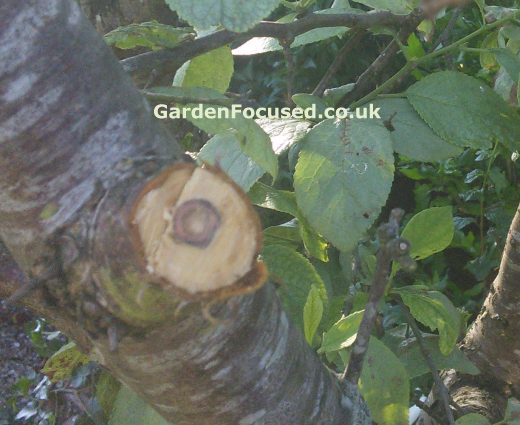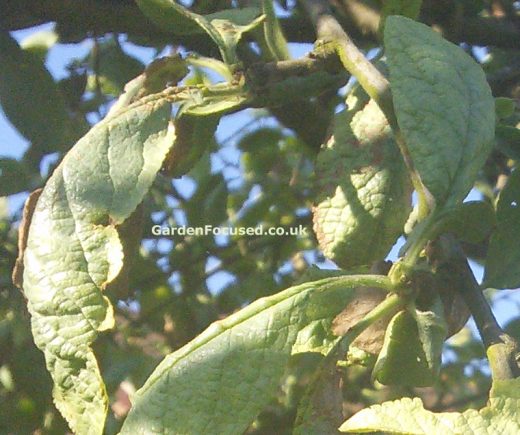There are three sections to this article:
- The symptoms of Silver Leaf disease.
- Treatment and prevention of Silver Leaf disease.
- The life cycle of the disease
SYMPTOMS OF SILVER LEAF DISEASE
The symptoms of Silver Leaf disease need to be investigated carefully because the treatment can be quite drastic and the disease can be mistaken for environmental conditions. Use the next couple of paragraphs to positively identify this disease. The key symptoms are:
- A silver sheen to some of the leaves. Consider other causes if the majority of leaves have a silver sheen to them. A closer look at the affected leaves will show that they have nothing on their surface which might be the cause of the apparent colour change. See lower down for the reasons why the leaves turn silver.
- Some branches may well die back. You may or may not realise it but affected branches will be those which were incorrectly pruned or damaged in the previous year(s).
- Affected branches may have fungi on them, these fungi are sometimes referred to as fruiting bodies. These look a bit like flat toadstools. They can vary in size and shape. Initially they are a purple coloured but they turn brown in summer.
- If you cut through an infected branch which is greater than 3cm / 1in wide there will be dark brown marks in the wood. If these aren’t visible try wetting the wood which often makes the brown marks become more visible. These brown marks are the most positive sign of Silver Leaf disease and are rarely caused by anything else.

The leaves of an infected tree are not infected by this fungus it is only the wood which is infected. The silver sheen to the leaves is caused by the top layer of the leaves separating from the layer below as a reaction to the fungal infection in the bark. When the two layers separate light is reflected differently making the leaves look a different colour.

Leaves with a silver sheen to them
It is important to realise that a silver sheen to leaves is not always caused by Silver Leaf disease. It can also be caused by environmental factors such as late frosts when the leaves have formed. Always look for other signs of the disease as well such as the marks in the wood or dead / dying branches. Also, environmental factors tend to affect the majority of leaves on the tree very quickly whereas Silver Leaf disease tends to be restricted to areas around the infected branch although if left untreated it will spread beyond that area.
TREATMENT AND PREVENTION
Treatment of Silver Leaf disease is based on the following factors
- This is a fungal infection that affects the wood of the tree.
- Removal of all infected wood is the only treatment possible.
- If the fungal infection reaches the trunk of tree then the entire tree is affected.
- The infection spreads throughout the tree via the sap in the wood.
- The infection can be spread to nearby plants (plum, cherry, rhododendron, fruit bushes and more) via spores.
The treatment for Silver Leaf is simple but brutal. All infected wood needs to be cut back to healthy wood – about 3cm / 1in further than marks in the wood. All prunings should be burnt to avoid re-infecting the tree and other nearby plants.
In some cases Silver Leaf disease cures itself but there is no known reason why this occurs. The choice between hard pruning and leaving the tree to fend for itself is yours. If there are other susceptible tree / plants nearby then in almost all cases, hard-pruning is the only option to avoid the risk of the disease spreading.
If you end up with the situation where you prune branches away and they are still marked at the point where they join the main trunk of the tree then it’s really time to give up, dig up all the tree including roots and burn everything.
Silver Leaf Disease can be transferred from one tree to another by using unsterilised saws, secateurs etc. So be sure to sterilise all pruning tools after using them. Jeyes Fluid is an ideal and cheap cleaning solution. Leave it on the tool surfaces for 20 minutes and then rinse or wipe off.
Preventing Silver Leaf disease is simply a matter of caring for the trees as best as you can, see our article on caring for plum trees. Key to this care is pruning your plum or cherry tree at the right time of year. Late May to mid July are the best times to prune plums and cherries if you want to minimise the risk of infection. As soon as you get into August the risk of infection increases as time passes. Pruning in late summer and autumn also deprives the tree of the goodness stored in the leaves which may reduce its health in subsequent years.
One plum tree in particular is prone to this disease and that is Victoria, and in particular when grown on the “Brompton” rootstock. The rootstock “Pixie” has good resistance to Silver Leaf even for Victoria plum trees. It is dwarfing, very widely available and an excellent choice.
LIFE CYCLE OF SILVER LEAF DISEASE
Silver Leaf is a fungal disease that is active above freezing temperatures and spreads through spores which are windborne. The key lifecycle stages are:
- The fungi, which grow on infected branches, release spores in autumn and early winter when conditions are wet and and above freezing.
- If the spores land on damaged wood they will enter it and infect the branch. Spores can be spread several miles if conditions are correct for them. Typically the damage has been caused by pruning late in the year or branches which have broken.
- The infection spreads slowly throughout the tree wood and will cause changes in the leaves although the leaves themselves are not infected.
- When stems and branches are killed by the infection, fungi begin to form continuing the life cycle.
REPLANTING PLUM TREES AFTER SILVER LEAF
There’s no hard evidence about whether it’s OK to replant a new plum tree in the same place where a tree has previously been infected with Silver Leaf. Possibly the reason for this is that most experts would not recommend planting a new fruit tree in the same position as a previous one whatever diseases have been present. So the short advice is no, don’t plant in the same position. If there is no other alternative make sure all of the stump of the old tree is removed including the roots and replace as much of the nearby soil as possible with new soil.
If you have any questions about Silver Leaf Disease or general comments about this article, use the form below to send them to us. We will get back to you as soon as possible.
COMMENTS / QUESTIONS LEFT BY OUR READERS
| Date: 3 May 2018 | From: Deb G |
| QUESTION: I have, what I think is a large prunus serrulata. It was pruned in February, but a more severe pruning 3 years ago (both, I now realise, in the winter….wrong time of year!). The bark has developed white spots and the red leaves are ragged and obviously have the silver leaf sheen. It is affected all over. Is this the end for my (rather large) tree? I don’t know how old it is but the house was built in 1988.
ANSWER: With such a prized tree I would be very cautious about diagnosing Silver Leaf disease at this stage because your description of the problem raises some questions. Firstly, Silver Leaf disease is a progressive disease and initially the silver sheen to the leaves is only visible surrounding an infected branch. It does not suddenly appear all over the tree, it takes several years to do that on a medium to large tree. Although the name Silver Leaf may imply that the leaves are infected, they are not. It is simply a reaction of the tree to infected branches. So your comment about the leaves being ragged rather suggests that the problem may not be Silver leaf. The white spots on the bark are a bit of a mystery but may well be something else altogether. A silver sheen to leaves on cherry trees, especially when a large number of them are affected in a short period of time, is more likely to be environmental. My first guess would be that the harsh winter we have just experienced has affected the development of the leaves and the tree may well return to normal next year. Certainly, give the tree at least one more year before disposing of it would be my advice. |
|
| Date: 8 August 2016 | From: Ralph |
| QUESTION: We have sadly got a plum tree which needs to be removed due to excessive silver leaf disease. Is it necessary to put chemical on the stump to kill off the roots or will they eventually die back through lack of food? If a chemical is needed, which one is best?
ANSWER: I don’t think there is a chemical to eradicate Silver Leaf so that’s not really an option. When the tree is cut down dampen the top of the stump to see if there is a ring of brown wood in the centre of it – see the first picture on this page. If there is no brown ring you can be fairly safe in leaving the stump to rot away naturally. If there is a brown ring then the stump will be infected and the ideal is to remove the stump and the roots. If that’s not feasible (something I have not yet encountered) then I suggest you read the RHS page on the options you have. See the link here. |
|
| Date: 21 June 2015 | From: Gillian Smith |
| Just removed Victoria plum with bad silver leaf. Please can you help me with this. Looking at the attached photos, could this be silver leaf disease on my Victoria plum tree? It’s a small tree and about half the tree is affected. If it is, and I cut off the affected branches, might I be able to save the tree?
ANSWER: It is almost certainly Silver Leaf and the pictures you sent (see main article above) confirm this. Your only option is to cut back to good, clean wood. If this is done there is no guarantee of cure but the chances are good. Burn the affected wood. |
|
| Date: 28 August 2014 | From: Ann |
| Just removed Victoria plum with bad silver leaf. Can I replant in the same place?
ANSWER: See the paragraph on this subject in the main article which has been added to answer your question. Remember to use a Silver Leaf resistant rootstock such as Pixie. |
|
WHY NOT LEAVE YOUR QUESTION / COMMENTS ABOUT THIS PAGE?
ENTER THEM BELOW. EMAIL ADDRESS IS OPTIONAL.
YOUR COMMENTS WILL BE ADDED ABOVE WITHIN A FEW HOURS.
[contact-form-7 id=”1882″ title=”Contact form 1″]
IDENTIFY AND TREAT SILVER LEAF DISEASE IN THE UK
By David Marks
Silver Leaf disease can affect a variety of trees. This page page deals specifically with plum and cherry trees because the pruning rules are the same for both.
The technical name for this disease is Chondrostereum purpureum which is a fungal infection of tree wood. Useful to know if you do more research after reading our article.